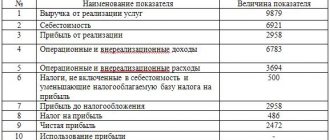What are the types of wages?
In labor relations, several dozen types of wages can be distinguished. In a private enterprise, the salary can be presented (clause 2 of the Regulations on the specifics of the procedure for calculating the average salary, approved by Decree of the Government of Russia dated December 24, 2007 No. 922):
- payments at a tariff or salary - for time worked;
- payments at piece rates;
- percentage of sales (commission);
- non-cash income;
- royalties;
- allowances, additional payments, bonuses, rewards for labor results;
- payments for special working conditions, etc.
In 2021, payroll in these types can be carried out using a wide range of methods. At the same time, these types of wages can be combined with each other in any way - in accordance with the wage system operating at the enterprise.
You can learn more about the use of various remuneration schemes in an enterprise in the article “Calculation of wages to employees - procedure and formula.”
If we talk about traditional payroll schemes, then these include (letter from the State Planning Committee of the USSR, the Ministry of Finance of the USSR, the State Committee for Prices of the USSR No. 10-86/1080, the Central Statistical Office of the USSR dated 06/10/1975 No. AB-162/16-127):
- a time-based scheme, which is based on the calculation of salary payments based on time worked;
- piecework scheme, which is based on the calculation of wages for work results measured objectively or assessed according to established criteria.
Let's study in more detail how wages are calculated within the framework of the 2 most common payment schemes - time-based and piece-rate.
ConsultantPlus experts explained how to calculate wages under other remuneration systems. Get trial access to the system and upgrade to the Ready Solution for free.
How are wages calculated for time-based wages?
Time-based (time-based bonus) wages are most often found in the following 2 varieties:
- When the salary is calculated based on the employee’s monthly salary (supplemented in the prescribed manner with bonuses for labor results).
In this case, the following formula is used to calculate wages:
SALARY = (OP / RD) × OD,
Where:
SALARY - salary for the billing period;
OP - the employee’s official salary, supplemented by bonuses if any;
RD - the number of working days in the month that includes the billing period;
OD - days worked in the billing period.
Attention! Salaries must be paid at least twice a month (Article 136 of the Labor Code of the Russian Federation), therefore the billing period cannot exceed half a month (letter of the Ministry of Labor and Social Protection of Russia dated September 21, 2016 No. 14-1/B-911). In this case, salary accrual is displayed in the accounting registers on the last day of the month.
- When the salary is calculated based on the tariff rate per 1 hour or 1 day.
In this case, the following formulas are used to calculate wages:
- for hourly wages:
SALARY = NHT × PCH,
Where:
CHTS - hourly tariff rate under an employment contract,
OCH - the number of hours worked during the reporting period;
- for daily wages:
SALARY = DTS × OD,
where DTS is the daily tariff under the employment contract.
In both cases, the employee receives pay for weekends and holidays:
- when performing work on weekends and holidays - at a double tariff rate (Article 153 of the Labor Code of the Russian Federation);
- when resting on such days - in accordance with local regulations (Article 112 of the Labor Code of the Russian Federation).
In the scenario under consideration, salary calculation is carried out taking into account the fact that the employer is obliged to establish monthly standards (Articles 160, 162 of the Labor Code of the Russian Federation):
- by working hours;
- by production.
The basis for such standards may be, for example, standard indicators for the industry in which the employing company operates.
If the standards established by the employer are met, the employee in any case receives a salary no less than the minimum wage established in the constituent entity of the Russian Federation (Article 133 of the Labor Code of the Russian Federation).
Is it possible not to pay a salary to the director of a company? Find out the answer in ConsultantPlus by receiving free trial access to the system.
Now let’s talk about how wages are calculated under the piecework scheme.
Difference between salary and wages
Wages are the financial reward of a worker, which is given for the fulfillment of labor obligations. The salary amount is set by a number of criteria. These include the level of qualifications of the employee himself, the quality of fulfillment of labor obligations and working conditions, as well as production volume. Also, the concept of wages can include additional payments of a compensatory or stimulating nature.
Remuneration is a system on the basis of which payments are made to employees for the fulfillment of labor obligations . This system is regulated by laws and local agreements that apply within a particular company. This type of payment is carried out by the administration of each enterprise. It should be emphasized that “wages” have a deeper meaning. It includes both the methodology for calculating wages and internal labor regulations, as well as the timing of the issuance of funds.
Payroll calculation under the piecework wage system: nuances
With piecework wages, as with the second option of time-based wages, which we discussed above, the employer also sets monthly standards for working time and output. Exceeding the relevant standards can increase piecework wages:
- Proportional to production.
Example
Electrical engineer Ivanov works at a television assembly plant. He receives a salary based on a piece-rate scheme, in which the employer has set a standard for assembling 2 televisions within 8 working hours. If it is completed, Ivanov receives 2,000 rubles (tariff: 1,000 rubles for 1 assembled TV).
For each subsequent assembled TV, Ivanov receives 1,000 rubles, regardless of the volume of production.
- Using a progressive scale.
Example
Machine operator Petrov works at a fastener production plant in the bolt production shop. He receives a piece-rate salary, according to which the employer sets a standard for production: 100 bolts within 8 working hours. When it is completed, Petrov receives 390 rubles (tariff - 3 rubles 90 kopecks for 1 bolt).
For every 50 additional bolts collected, Petrov receives 10 rubles apiece. For every 50 following them - 20 rubles. For each subsequent bolt - 30 rubles.
In some cases, a regressive scale may also be used. For example, when the production model of an enterprise requires employees to fulfill planned targets as accurately as possible without significantly exceeding them (as an option, in order to increase the efficiency of control over costs of raw materials).
A separate type of salary is the one that is paid during the employee’s business trip (Articles 139, 167 of the Labor Code of the Russian Federation). Let's study the specifics of its calculation.
Primary documents on wages
The form of some primary documents on wages is regulated and approved by the Resolution of the State Statistics Committee of the Russian Federation dated January 5, 2004 No. 1 “On approval of unified forms of primary accounting documentation of labor and its payment.”
These include:
- The time sheet is used for automated recording of employee attendance at the workplace; it is used in companies equipped with special reading and recognition systems that record the date and time of the employee’s arrival at the workplace.
- The timesheet for recording working hours and calculating wages is used in most organizations for accounting payroll calculations; it is a universal document that confirms the actual performance of work by the employee.
- Payroll , payroll and payroll are used for calculating and paying wages; if the T-49 form is available, others are not drawn up; when paying wages to bank cards, only the T-51 form is used.
- A note-calculation on granting leave to an employee is used to calculate vacation pay.
- A note indicating the termination of an employment contract with an employee is used when calculating wages, unused vacation, and other payments upon dismissal.
- Personal account - required to display accounting of all data on wages, accruals and deductions during the calendar year.
- Act on acceptance of work performed under a fixed-term employment contract concluded for the duration of a specific job.
Business trip on weekends: how is salary calculated?
How to calculate salary for weekends during a business trip? This problem is solved using the formula:
RVK = DT × RV × 2,
Where:
DT - the employee’s daily tariff in accordance with the accepted wage system (letter of the Ministry of Labor and Social Protection of Russia dated December 25, 2013 No. 14-2-337);
PB - days off worked.
The DT indicator can be directly determined in the employment contract or calculated using the formula:
DT = OKL / RDM,
Where:
OKL - salary (with allowances and bonuses, if provided for in the contract) for the month in which the person was on a business trip);
RDM - the number of working days in the corresponding month.
In addition to the salary in the form of average earnings, the posted employee is also paid a daily allowance.
You can find out how daily allowances are calculated in the article “Amount of daily allowances for business trips (nuances).”
Rest compensation
Officially employed persons are granted annual leave. The right to use them arises after six months of continuous work. In some cases, leave can be granted before this time, subsequent ones - strictly according to the schedule. The basis for the calculation is an order indicating the employee’s data and the duration of the break, which at the legislative level is at least 28 calendar days.
Additional wages are calculated based on average salaries and number of days. For calculation purposes, a period of three calendar months is used that precedes the start of the vacation. The following times and amounts are excluded from the billing period:
- the employee received “sick leave”;
- the employee was on vacation at his own expense;
- the employee did not work due to downtime that was not his fault;
- the employee was unable to perform duties due to a strike;
- for other reasons.
If during the billing period there is a change in tariff rates at the enterprise, then the employee’s salary must be adjusted accordingly. Recalculation is carried out in different ways:
- if the changes affected the billing period, then the rates are adjusted;
- if the salary was increased before the start of the vacation, then the average salary increases;
- conditions changed during vacation - only the part of the salary that falls during the period of change is adjusted.
The exchange of vacation for monetary remuneration is allowed only in part exceeding 28 days (Article 126 of the Labor Code of the Russian Federation). If an employee resigns, he is compensated for unused vacation time. Additional wages are calculated based on the average daily salary. For valid reasons, an employee may be sent on leave without pay for an individually considered period.
Example
An employee of the organization received leave from October 20 for 28 days. In July and August, his earnings amounted to 5 thousand rubles, monthly bonus - 2 thousand rubles, quarterly remuneration - 4 thousand rubles. The calculations will use the average monthly number of days in the calendar – 29.6.
First you need to determine the amount of bonus payments. They are counted no more than one for each indicator. Therefore, all three things can be included in the calculation. The quarterly bonus is taken into account in full.
Annual remuneration: 4 × 3: 12 = 1 thousand rubles.
Bonus amount: (2 × 3) + 4 + 1= 11 thousand rubles.
The additional salary is: (15 + 11) : 3 : 29.6 × 28 = 8198.12 rubles.
Business trip
The manager was on a business trip for 3 days. His salary for the billing period was 23 thousand rubles, an allowance for combinations - 30%, and a bonus - 15%. The number of days worked is 247. The total amount to be paid will be: (23 + 23 × 30%) × 12 + 23 × 15% = RUB 362,250.
Average salary: 362,250 rubles: 247 days = 1,467 rubles. – this amount is due to the employee per day.
Business travel: 1,467 × 3 = 4,399.80 rubles.
Vacation
Let's take the conditions of the previous example and calculate the amount of payment for 28 days.
The total payment amount remains the same – 362.25 thousand rubles.
Average earnings: 362,250: (29.6: 12) = 1,468.3 thousand rubles.
Vacation pay: 1468.3 × 28 = 41112.40 rubles.
Payroll and taxation in 2021
An employee’s salary, including those represented by vacation pay and travel allowances, is subject to:
- Personal income tax at the rate:
- 13% - if the employee has tax resident status;
- 15% - from 01/01/2021 for income exceeding 5 million rubles. in a year;
- 30% - if the employee does not have resident status.
In the case of applying a tax deduction, personal income tax at a rate of 13% is not charged on the part of the salary amount within the amount of the deduction. At a personal income tax rate of 30%, the deduction cannot be applied.
Personal income tax on wages is accrued at the moment it is recognized as income - on the last day of the month for which wages are calculated (clause 2 of Article 223 of the Tax Code of the Russian Federation). Withheld - at the time of payment. Transferred to the budget no later than the next business day after payment.
Thus, if an employee’s income is transferred before the end of the month, then personal income tax is withheld and transferred to the budget only from the next nearest payment.
- Contributions to social funds (the main part of which is collected through the mediation of the Federal Tax Service):
- to the Pension Fund;
- to the Social Insurance Fund (without the mediation of the Federal Tax Service, the fund collects contributions for injuries);
- in FFOMS.
Contribution rates are divided into standard, increased and reduced, which are established for certain categories of enterprises. Contributions are calculated on salary without deduction of personal income tax.
The deadline for paying all contributions is until the 15th day of the month for which the employee is paid.









